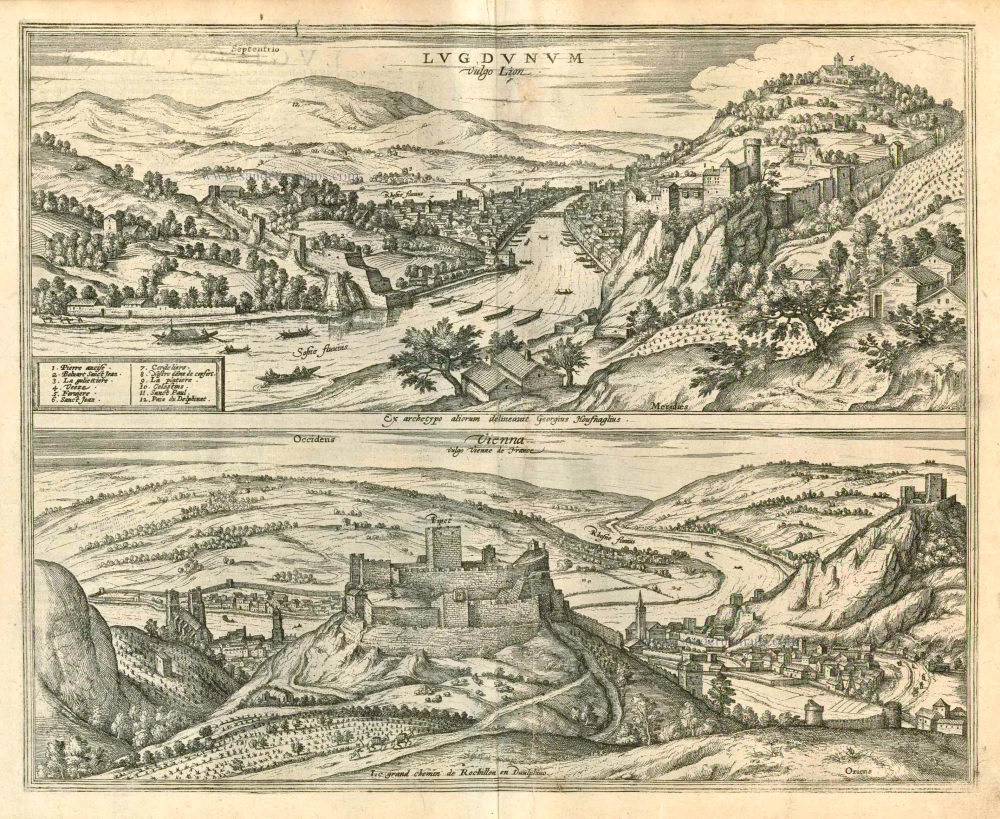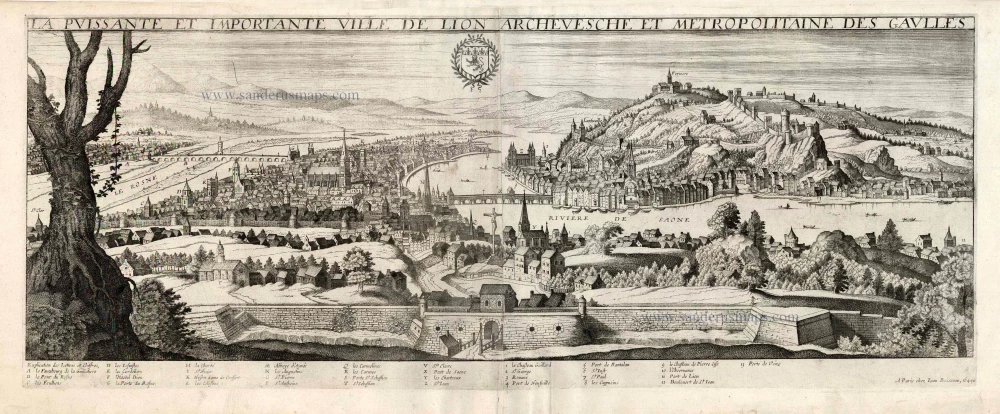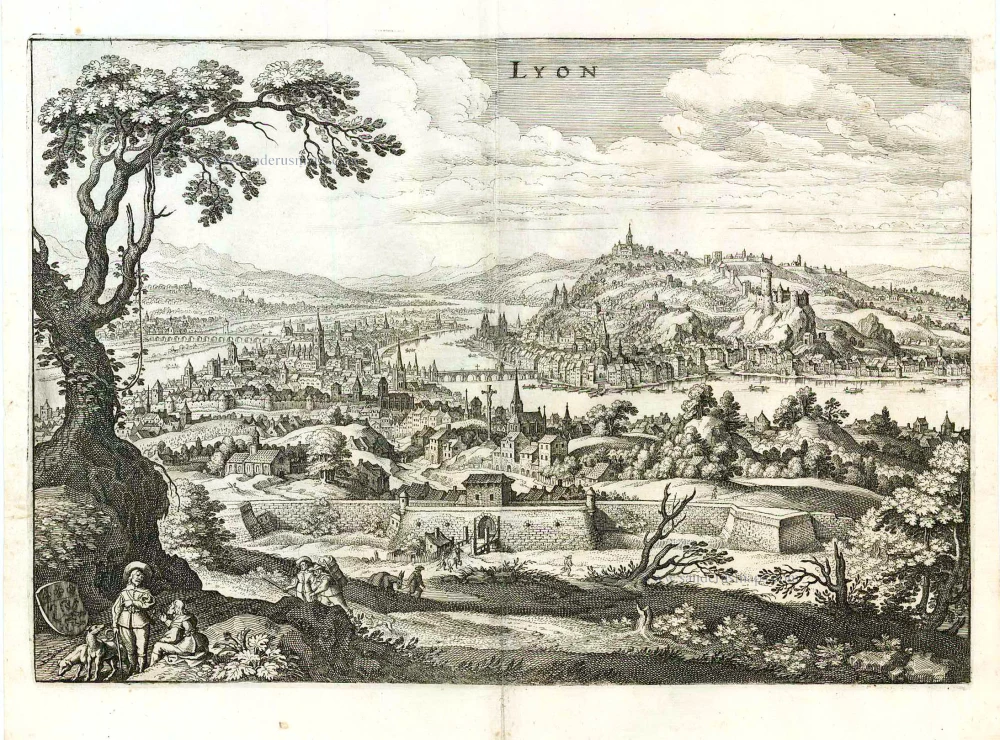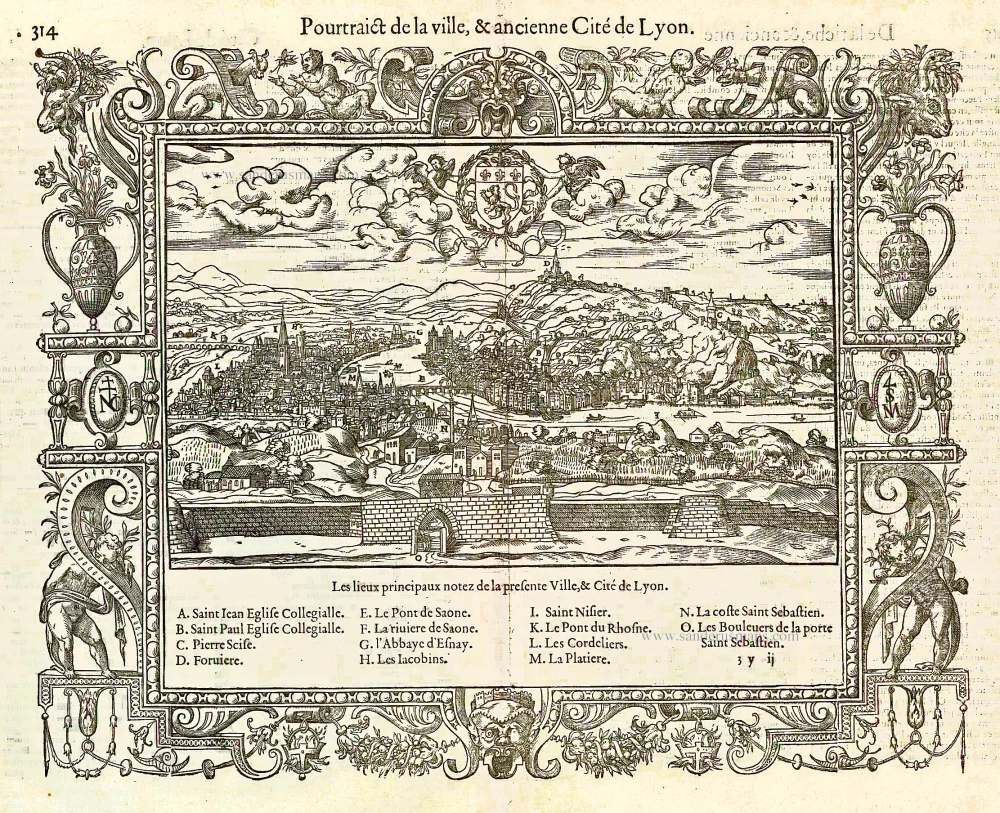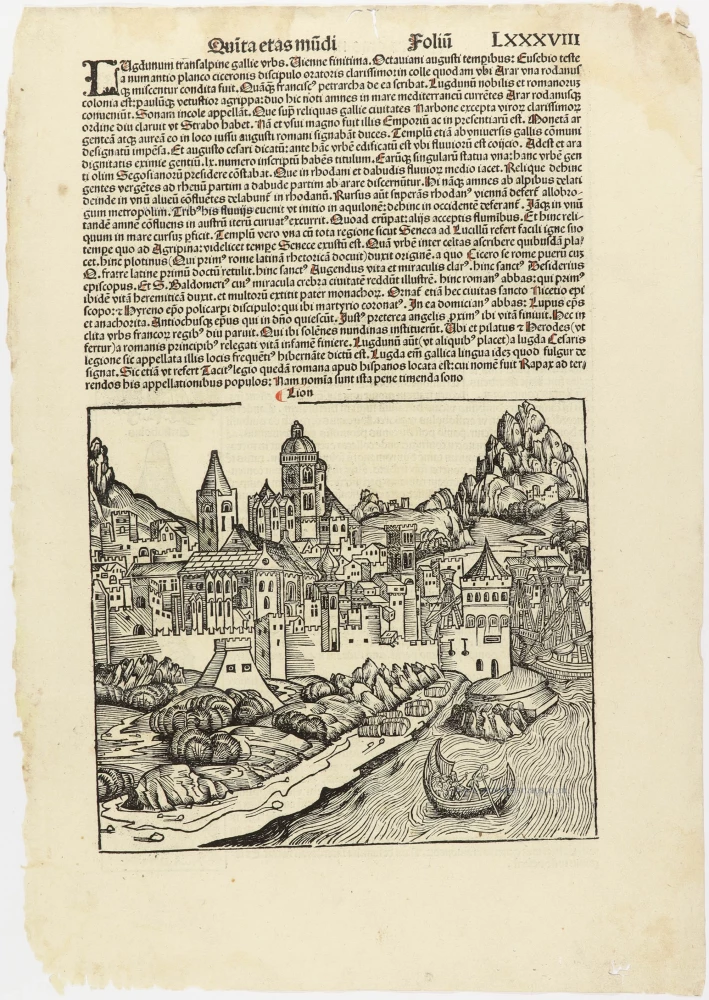Lyon and Vienne, by Georg Braun and Frans Hogenberg. 1596
LYON
CAPTION: Lugdunum, in the vernacular Lyon.
Signed centre: Drawn by Georg Hoefnagel after the original by another artist.
COMMENTARY BY BRAUN: "Lyons is flanked on one side by two densely forested mountains; on the other side flows the Rhône and the Saône. The city lies, so to speak, in the middle of Europe and hence is also considered the heart of France. [...] The merchants visit the important fairs four times a year."
Lyons is seen here from a slightly elevated position to the north. The viewpoint is particularly advantageous as it allows the confluence of the Rhône and Saône, the fortress and the surrounding hills, as well as the situation and layout of the city to be seen at a glance. Visible are the ramparts leading down to the Rhône on the left and ascending steeply past Mount Fourvière on the right.
VIENNE
CAPTION: Vienna, in the vernacular Vienne de France.
COMMENTARY BY BRAUN: "Vienne, the capital of the Dauphiné, is one of the oldest cities in France; it borders the Rhône and the territory of Lyons, which is why it lived in discord with Lyons in the past. That Vienne is a very ancient city can also be seen from the bridge over the Rhône, which was built by Tiberius Gracchus on his march through Gaul and who has a castle built on both sides as a garrison."
The view of Vienne is dominated in the foreground by Mount Pipet with its fortress, whose site remains only a chapel and a statue of the Virgin from the 19th century. Within the city itself, which runs along the bank of the Rhône at the foot of Mount Pipet, the Romanesque monastery church of Saint-André-Le-Bas is visible on the right, whereas on the far left, one of France's oldest churches can be seen, the former cathedral of Saint-Pierre, whose origins date back to the 5th century. Vienne is famous above all for its Roman past: Roman legionaries settled in the later colony of Vienna as early as the last quarter of the 2nd century BC. Numerous vestiges from this era have survived up to the present, including the Roman theatre, still used today, and the temple of Augustus and Livia.
Hoefnagel drew this view after a pen drawing in the Berlin Kupferstichkabinett done between 1568 and 1572 by an anonymous artist called Fabriczy, a pupil of Pieter Brueghel, the Elder.
Braun G. & Hogenberg F. and the Civitates Orbis Terrarum.
The Civitates Orbis Terrarum, also known as the 'Braun & Hogenberg', is a six-volume town atlas and the most excellent book of town views and plans ever published: 363 engravings, sometimes beautifully coloured. It was one of the best-selling works in the last quarter of the 16th century. Georg Braun, a skilled writer, wrote the text accompanying the plans and views on the verso. Many plates were engraved after the original drawings of a professional artist, Joris Hoefnagel (1542-1600). The first volume was published in Latin in 1572 and the sixth in 1617. Frans Hogenberg, a talented engraver, created the tables for volumes I through IV, and Simon van den Neuwel made those for volumes V and VI. Other contributors were cartographers Daniel Freese and Heinrich Rantzau, who provided valuable geographical information. Works by Jacob van Deventer, Sebastian Münster, and Johannes Stumpf were also used as references. Translations appeared in German and French, making the atlas accessible to a broader audience.
Since its original publication of volume 1 in 1572, the Civitates Orbis Terrarum has left an indelible mark on the history of cartography. Seven more editions followed the first volume in 1575, 1577, 1582, 1588, 1593, 1599, and 1612. Vol.2, initially released in 1575, saw subsequent editions in 1597 and 1612. The subsequent volumes, each a treasure trove of historical insights, graced the world in 1581, 1588, 1593, 1599, and 1606. The German translation of the first volume, a testament to its widespread appeal, debuted in 1574, followed by the French edition in 1575.
Several printers were involved: Theodor Graminaeus, Heinrich von Aich, Gottfried von Kempen, Johannis Sinniger, Bertram Buchholtz, and Peter von Brachel, all of whom worked in Cologne.
Georg Braun (1541-1622)
Georg Braun, the author of the text accompanying the plans and views in the Civitates Orbis Terrarum, was born in Cologne in 1541. After his studies in Cologne, he entered the Jesuit Order as a novice, indicating his commitment to learning and intellectual pursuits. In 1561, he obtained his bachelor's degree; in 1562, he received his Magister Artium, further demonstrating his academic achievements. Although he left the Jesuit Order, he continued his studies in theology, gaining a licentiate in theology. His theological background likely influenced the content and tone of the text in the Civitates Orbis Terrarum, adding a unique perspective to the work.
Frans Hogenberg (1535-1590)
Frans Hogenberg was a Flemish and German painter, engraver, and mapmaker. He was born in Mechelen as the son of Nicolaas Hogenberg.
By the end of the 1560s, Frans Hogenberg was employed upon Abraham Ortelius's Theatrum Orbis Terrarum, published in 1570; he is named an engraver of numerous maps. In 1568, he was banned from Antwerp by the Duke of Alva and travelled to London, where he stayed a few years before emigrating to Cologne. He immediately embarked on his two most important works, the Civitates, published in 1572 and the Geschichtsblätter, which appeared in several series from 1569 until about 1587.
Thanks to large-scale projects like the Geschichtsblätter and the Civitates, Hogenberg's social circumstances improved with each passing year. He died as a wealthy man in Cologne in 1590.
Lugdunum vulgo Lion [on sheet with] Vienna vulgo Vienne
Item Number: 24150 Authenticity Guarantee
Category: Antique maps > Europe > France - Cities
Old, antique view of Lyon and Vienne, by Georg Braun and Frans Hogenberg.
Title: Lugdunum vulgo Lion [on sheet with] Vienna vulgo Vienne
Date of the first edition: 1596.
Date of this map: 1596.
Copper engraving, printed on paper.
Size (not including margins): 375 x 465mm (14.76 x 18.31 inches).
Verso: Latin text.
Condition: Uncoloured, excellent.
Condition Rating: A+.
From: Urbium Praecipuarum Mundi Theatrum Quintum Auctore Georgio Braunio Agrippinate. Part 5. Köln, 1596/97. (Van der Krogt 4, 41:1.5)
LYON
CAPTION: Lugdunum, in the vernacular Lyon.
Signed centre: Drawn by Georg Hoefnagel after the original by another artist.
COMMENTARY BY BRAUN: "Lyons is flanked on one side by two densely forested mountains; on the other side flows the Rhône and the Saône. The city lies, so to speak, in the middle of Europe and hence is also considered the heart of France. [...] The merchants visit the important fairs four times a year."
Lyons is seen here from a slightly elevated position to the north. The viewpoint is particularly advantageous as it allows the confluence of the Rhône and Saône, the fortress and the surrounding hills, as well as the situation and layout of the city to be seen at a glance. Visible are the ramparts leading down to the Rhône on the left and ascending steeply past Mount Fourvière on the right.
VIENNE
CAPTION: Vienna, in the vernacular Vienne de France.
COMMENTARY BY BRAUN: "Vienne, the capital of the Dauphiné, is one of the oldest cities in France; it borders the Rhône and the territory of Lyons, which is why it lived in discord with Lyons in the past. That Vienne is a very ancient city can also be seen from the bridge over the Rhône, which was built by Tiberius Gracchus on his march through Gaul and who has a castle built on both sides as a garrison."
The view of Vienne is dominated in the foreground by Mount Pipet with its fortress, whose site remains only a chapel and a statue of the Virgin from the 19th century. Within the city itself, which runs along the bank of the Rhône at the foot of Mount Pipet, the Romanesque monastery church of Saint-André-Le-Bas is visible on the right, whereas on the far left, one of France's oldest churches can be seen, the former cathedral of Saint-Pierre, whose origins date back to the 5th century. Vienne is famous above all for its Roman past: Roman legionaries settled in the later colony of Vienna as early as the last quarter of the 2nd century BC. Numerous vestiges from this era have survived up to the present, including the Roman theatre, still used today, and the temple of Augustus and Livia.
Hoefnagel drew this view after a pen drawing in the Berlin Kupferstichkabinett done between 1568 and 1572 by an anonymous artist called Fabriczy, a pupil of Pieter Brueghel, the Elder.
Braun G. & Hogenberg F. and the Civitates Orbis Terrarum.
The Civitates Orbis Terrarum, also known as the 'Braun & Hogenberg', is a six-volume town atlas and the most excellent book of town views and plans ever published: 363 engravings, sometimes beautifully coloured. It was one of the best-selling works in the last quarter of the 16th century. Georg Braun, a skilled writer, wrote the text accompanying the plans and views on the verso. Many plates were engraved after the original drawings of a professional artist, Joris Hoefnagel (1542-1600). The first volume was published in Latin in 1572 and the sixth in 1617. Frans Hogenberg, a talented engraver, created the tables for volumes I through IV, and Simon van den Neuwel made those for volumes V and VI. Other contributors were cartographers Daniel Freese and Heinrich Rantzau, who provided valuable geographical information. Works by Jacob van Deventer, Sebastian Münster, and Johannes Stumpf were also used as references. Translations appeared in German and French, making the atlas accessible to a broader audience.
Since its original publication of volume 1 in 1572, the Civitates Orbis Terrarum has left an indelible mark on the history of cartography. Seven more editions followed the first volume in 1575, 1577, 1582, 1588, 1593, 1599, and 1612. Vol.2, initially released in 1575, saw subsequent editions in 1597 and 1612. The subsequent volumes, each a treasure trove of historical insights, graced the world in 1581, 1588, 1593, 1599, and 1606. The German translation of the first volume, a testament to its widespread appeal, debuted in 1574, followed by the French edition in 1575.
Several printers were involved: Theodor Graminaeus, Heinrich von Aich, Gottfried von Kempen, Johannis Sinniger, Bertram Buchholtz, and Peter von Brachel, all of whom worked in Cologne.
Georg Braun (1541-1622)
Georg Braun, the author of the text accompanying the plans and views in the Civitates Orbis Terrarum, was born in Cologne in 1541. After his studies in Cologne, he entered the Jesuit Order as a novice, indicating his commitment to learning and intellectual pursuits. In 1561, he obtained his bachelor's degree; in 1562, he received his Magister Artium, further demonstrating his academic achievements. Although he left the Jesuit Order, he continued his studies in theology, gaining a licentiate in theology. His theological background likely influenced the content and tone of the text in the Civitates Orbis Terrarum, adding a unique perspective to the work.
Frans Hogenberg (1535-1590)
Frans Hogenberg was a Flemish and German painter, engraver, and mapmaker. He was born in Mechelen as the son of Nicolaas Hogenberg.
By the end of the 1560s, Frans Hogenberg was employed upon Abraham Ortelius's Theatrum Orbis Terrarum, published in 1570; he is named an engraver of numerous maps. In 1568, he was banned from Antwerp by the Duke of Alva and travelled to London, where he stayed a few years before emigrating to Cologne. He immediately embarked on his two most important works, the Civitates, published in 1572 and the Geschichtsblätter, which appeared in several series from 1569 until about 1587.
Thanks to large-scale projects like the Geschichtsblätter and the Civitates, Hogenberg's social circumstances improved with each passing year. He died as a wealthy man in Cologne in 1590.

